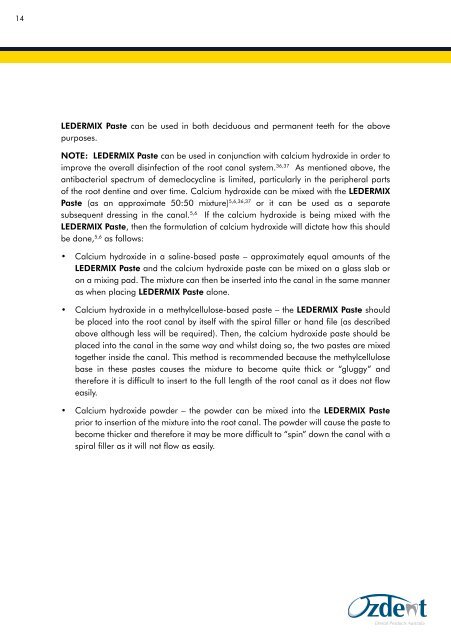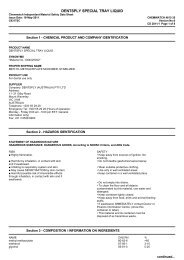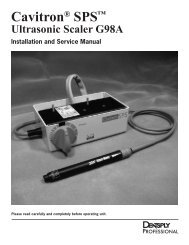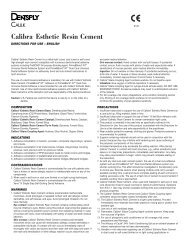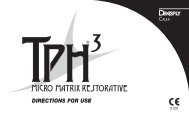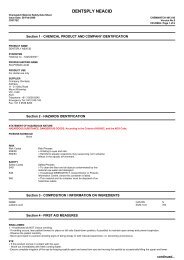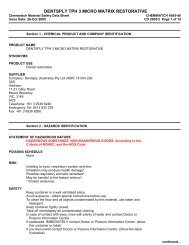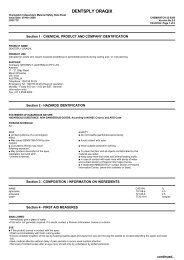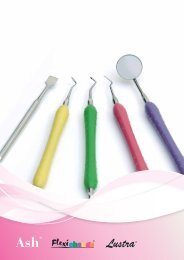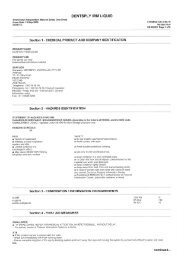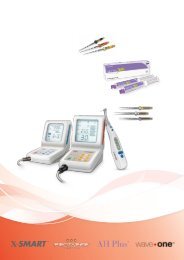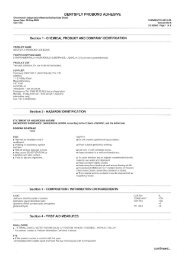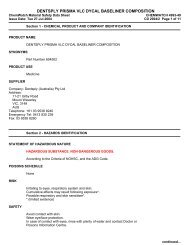The Materials - Dentsply
The Materials - Dentsply
The Materials - Dentsply
Create successful ePaper yourself
Turn your PDF publications into a flip-book with our unique Google optimized e-Paper software.
14 15<br />
<strong>The</strong><br />
<strong>Materials</strong><br />
LEDERMIX Paste can be used in both deciduous and permanent teeth for the above<br />
purposes.<br />
NOTE: LEDERMIX Paste can be used in conjunction with calcium hydroxide in order to<br />
improve the overall disinfection of the root canal system. 36,37 As mentioned above, the<br />
antibacterial spectrum of demeclocycline is limited, particularly in the peripheral parts<br />
of the root dentine and over time. Calcium hydroxide can be mixed with the LEDERMIX<br />
Paste (as an approximate 50:50 mixture) 5,6,36,37 or it can be used as a separate<br />
subsequent dressing in the canal. 5,6 If the calcium hydroxide is being mixed with the<br />
LEDERMIX Paste, then the formulation of calcium hydroxide will dictate how this should<br />
be done, 5,6 as follows:<br />
• Calcium hydroxide in a saline-based paste – approximately equal amounts of the<br />
LEDERMIX Paste and the calcium hydroxide paste can be mixed on a glass slab or<br />
on a mixing pad. <strong>The</strong> mixture can then be inserted into the canal in the same manner<br />
as when placing LEDERMIX Paste alone.<br />
• Calcium hydroxide in a methylcellulose-based paste – the LEDERMIX Paste should<br />
be placed into the root canal by itself with the spiral filler or hand file (as described<br />
above although less will be required). <strong>The</strong>n, the calcium hydroxide paste should be<br />
placed into the canal in the same way and whilst doing so, the two pastes are mixed<br />
together inside the canal. This method is recommended because the methylcellulose<br />
base in these pastes causes the mixture to become quite thick or “gluggy” and<br />
therefore it is difficult to insert to the full length of the root canal as it does not flow<br />
easily.<br />
• Calcium hydroxide powder – the powder can be mixed into the LEDERMIX Paste<br />
prior to insertion of the mixture into the root canal. <strong>The</strong> powder will cause the paste to<br />
become thicker and therefore it may be more difficult to “spin” down the canal with a<br />
spiral filler as it will not flow as easily.<br />
LEDERMIX CEMENT<br />
NOTE: LEDERMIX Cement is NOT suitable for use in teeth with<br />
irreversible pulpitis - such teeth require pulpectomy and root canal<br />
therapy, or extraction. Hence, an accurate diagnosis is essential<br />
and should be based on a thorough history, clinical examination,<br />
pulp sensibility tests and periapical radiograph(s).<br />
LEDERMIX Cement is indicated for use 15,16,27,38-44 in the following<br />
situations:<br />
• For the management of reversible pulpitis in both deciduous<br />
and permanent teeth by indirect pulp capping – that is, where<br />
there has not been a pulp exposure.<br />
• For the management of reversible pulpitis in both deciduous and permanent teeth<br />
by direct pulp capping or as a pulpotomy agent where the pulp has been exposed.<br />
In this situation, the clinician must decide whether to perform a direct pulp cap or a<br />
pulpotomy - this will depend on many factors including the age of the patient, status<br />
of the tooth, the size of the exposure, the type of restoration required, which tooth is<br />
being treated and its strategic value, financial considerations, etc.<br />
• Use as a lining or indirect pulp capping material in asymptomatic teeth with deep<br />
carious cavities prior to placing a restoration in order to reduce the inflammation that<br />
may have been present due to the caries and also to reduce the inflammatory effects<br />
of the operative procedures.<br />
• Use to cement interim crowns following preparation of the tooth for a crown<br />
restoration in order to reduce the inflammatory effects of the operative procedures.<br />
• Use as a root filling material in deciduous teeth with irreversible pulpitis or an infected<br />
root canal system following thorough canal cleaning and preparation.


